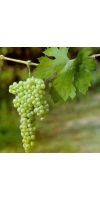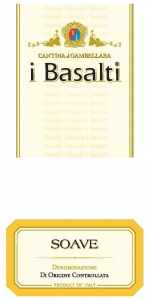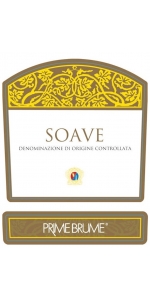Garganega

Garganega is one of the most underrated white grapes on the planet although it is also one of the most widely planted white grapes in Italy. Garganega grapes in the Veneto region are blended with Soave and Gambellara. Garganega is also blended with Trebbiano di Soave. Garganega, pronounced gahr-gah-HEH-gah, grape is not as popular as the Sangionvese grape and is often blended with Chardonnay. The late-ripening Garganega is well suited for sweet and luscious appassimento wines. Like Chardonnay, Garganega reflects the environment. When it is grown in a cooler climate, Garganega exhibits apple like characteristics that are reminiscent of Chablis, also exhibiting good structure that is derived from its well-defined acidity. Warmer regions produce Garganega with stone fruit, citrus flavors, and delicate expression. These characteristics can be softened if the vines are allowed to follow their natural inclination. This also allows the grapes to yield heavily. When produced in the appassimento style, Garganega grapes are richly textured with tropical fruits, exotic spices and honey that is combined with a backbone of citrus flavors and aromas. Garganega wines pair well with seafood, white meat, and risotto. The sometimes almond flavors and vibrant fruit quality also make it a delicious wine to enjoy before a meal.
Gambellara Soave I Basalti is made from 100 percent Garganega
Soave DOC (Denominazione di Origine Controllata)
Production area: Soave hills
Vineyard training system: Open pergola
Vinification: Destemming, maceration of the grapes in the must for 12 hours, racking and long fermentation at 18 °C
The color is a brilliant straw yellow with a fresh fruit perfumes, especially apple and pear, and floral notes such as elder and bloom. The taste is very fresh and light, with a very interesting acidity. There is an important presence of mineral salts due to the volcanic origin of the soil. Ideal as aperitif, light main courses such as pasta and risotto, shell fish and fish, soups and vegetables.
The color is a brilliant straw yellow with a fresh fruit perfumes, especially apple and pear, and floral notes such as elder and bloom. The taste is very fresh and light, with a very interesting acidity. There is an important presence of mineral salts due to the volcanic origin of the soil.
Open pergola Vinification: Destemming, maceration of the grapes in the must for 12 hours, racking and long fermentation at 18 °C
Ideal as aperitif, light main courses such as pasta and risotto, shell fish and fish, soups and vegetables.
Review:
Brilliant emerald straw color. Aromas and flavors of brazil nuts, creme fraiche, and kiwi and starfruit with a silky, lively, dry-yet-fruity light-to-medium body and an effortless, engaging, medium-length watermelon, yellow apple, and clementine finish. A delicious, artfully balanced soave with a great range of fruit flavors. 91 Point Beverage Tasting Institue
The color is a brilliant straw yellow with a fresh fruit perfumes, especially apple and pear, and floral notes such as elder and bloom. The taste is very fresh and light, with a very interesting acidity. There is an important presence of mineral salts due to the volcanic origin of the soil.
Open pergola Vinification: Destemming, maceration of the grapes in the must for 12 hours, racking and long fermentation at 18 °C
Ideal as aperitif, light main courses such as pasta and risotto, shell fish and fish, soups and vegetables.
Review:
Brilliant emerald straw color. Aromas and flavors of brazil nuts, creme fraiche, and kiwi and starfruit with a silky, lively, dry-yet-fruity light-to-medium body and an effortless, engaging, medium-length watermelon, yellow apple, and clementine finish. A delicious, artfully balanced soave with a great range of fruit flavors. 91 Point Beverage Tasting Institue
- back
Selected Options
Grape Types
Categories
Pricing
Countries
Regions
Grape Types
Wineries
Organic/Free Shipping
Thus, the first Édition of Krug Rosé, a singular Champagne achieving an astonishing balancing act between finesse and substance, came to be.
The story of Krug Rosé dates back to 1983. With Joseph’s non-conformist spirit at heart, the 5th generation of the Krug family gave birth to a new composition, a bold rosé inspired by the House’s reputed art of blending, to be re-created each year.
Krug Rosé is an unexpected rosé Champagne combining elegance and boldness – inspired by the dream of the fifth generation of the House of Krug to conceive a rosé Champagne that did not exist, a rosé Champagne that could be re-created every year.
Krug Rosé 27ème Édition is a blend of 38 wines from 9 different years, the youngest of which is from 2015, while the oldest dates back to 2005. ▪ It was completed with 10% traditionally macerated Pinot Noir of the year blended from plots in Aÿ and Mareuil-sur-Aÿ, to add a unique spiciness, colour and structure. Its final composition is 57% Pinot Noir, 23% Chardonnay and 20% Meunier. ▪ A stay of around seven years in Krug’s cellars gives Krug Rosé 27ème Édition its unique expression and elegance.
At first sight, its subtle pale pink colour holds a promise of elegance. On the nose, aromas of rose hips, cured ham, mulberries, redcurrant, peony, pepper and pink grapefruit. On the palate, delicate flavours of honey, citrus and dried fruit with a long finish, enhanced by its fine bubbles complete the experience.
Review:
Thirty-eight wines from nine vintages spanning 2005 to 2015 - 55% of them reserve - went into this blend of 57% Pinot Noir, 23% Chardonnay, and 20% Meunier; a nonpareil of shimmering depth. On the pure, precise nose, raspberries and roses mingle with suggestions of woodsiness, honey-cured ham, and parmesan rind before vibrating with white peach and red currant, honeyed cashew, and a soupcon of tobacco leaf and cucumber on the palate - where the tension between its almost ethereal refinement, thanks not least to the unending mousse, and the luxuriance of its finish is simply (or not so simply) delicious.
-Tasting Panel 99 Points
While the wine has sufficient tannins and structure for long-term bottle aging, Caymus Cabernet is dark and concentrated, with ripe, luxurious, fruit-driven softness that shows from the day of release.






